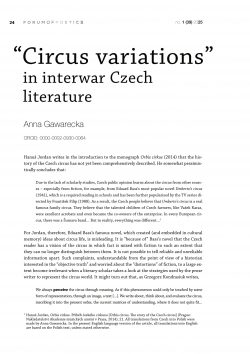
Anna Gawarecka
A b s t r a k t
In Czech interwar literature, the circus (similarly to other mass culture phenomena, e.g. sports or cinema) became the subject of complex analyses, inspiring axiological questions. At that time, cultural peripheries opened up new fields of thematic exploration for Czech literature. Some authors formulated sociological observations (novels by Ivan Olbracht, Karl Poláček, and Eduard Bass), while others were part of the avant-garde (Karel Teige, Vítězslav Nezval) and looked for the yet undiscovered sources of artistic inspiration. In both cases, the circus functioned as a topos – a signal that triggered both curiosity and fear and that was only partially “domesticated.” The circus was perceived as a “transgressive” (exotic and / or romantic) space in which the routine laws of everyday life were suspended. It demonstrated that an “alternative” way of life was possible and that the boundaries of the Other could be crossed.





